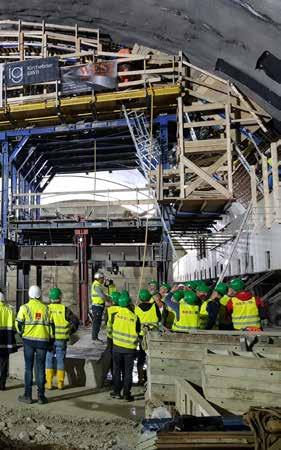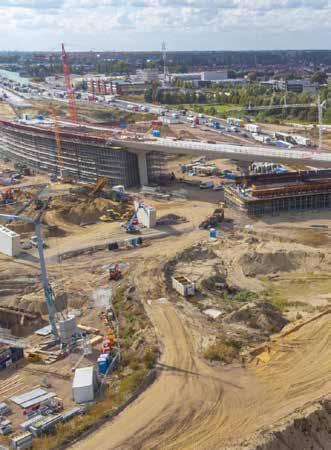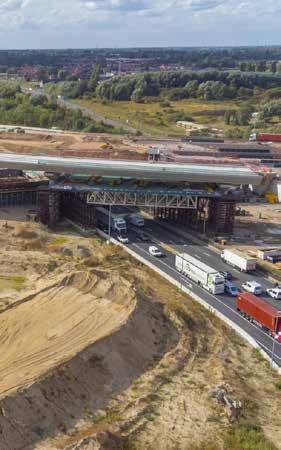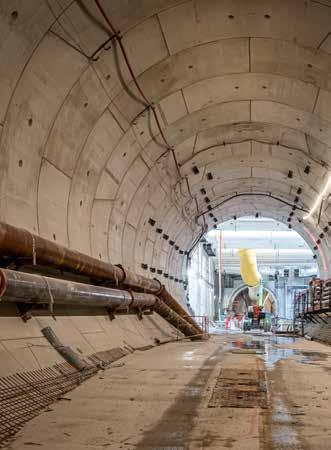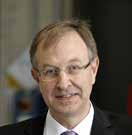EUROPE AND TUNNELING: CHALLENGES AND PERSPECTIVES
6
Underground infrastructure, underground architecture and sustainable development. These are the fields and the goals that must be systematized in order to o er a design-driven and strategic responses that bring together the impact of the construction industry on the environment and the development of solutions in which engineering fosters innovation, sustainability and inclusivity.
This issue, under the spotlight of the international economy thanks to the goals set by the United Nations in its Agenda for Sustainable Development, becomes particularly challenging when it moves into the space of the subsoil, with a focus on tunnels and spaces dedicated to a multitude of activities.
«We are living in the Anthropocene – commented Antonia Cornaro (Itacus) – a new era in which we are measuring man’s impact on the earth; consequently we are all forced to consider the environment and its needs».
7
Urbanisation: criticalities and solutions. «It is estimated today that 60% of the world’s population lives in urban areas and by the year 2030 two billion people will have moved into the city, with an unprecedented impact on the existing infrastructures and resources, for example the supply of water and energy». We are reminded of this framework by Michel De ayet, president of AFTES, the French association and cousin to SIG, which gathers the players in the tunnelling world. The expansion of city centres, land take, pollution and the consequences of transportation policies and more in general mobility, are decisive drivers in urban planning. Consequently, it is inevitable that we must rethink the strategies related to infrastructure, and in various European countries, tunnelling has become an argument in the political and economic agenda.
In this context, the international conference “The Role of Underground Infrastructure for the Achievement of the UN Sustainable Development Goals”, was promoted in Bologna as part of Saie (20 October 2022), which gathered around a table the international representatives of the EUTF “European Underground & Tunnel Forum”, i.e. the nine presidents of the national associations (Austria – ITA Austria, Belgium – ABTUS BVOTS, France – AFTES, Germany – DAUB, Italy – SIG, Netherlands –KIVI, Portugal – CPT, Spain – AETOS, Switzerland – STS) as references for their respective national communities and for the international community (International Tunnelling Association), a protagonist on the theme of underground infrastructure. Voices
and skills engaged in a debate dedicated to sustainable innovation.
From 2015 to 2030. Today we are halfway through the process to translate into action the 17 Sustainable Development Goals – framed within a wider action programme consisting of 169 goals associated with them in the environmental, economic, social and institutional spheres –and the world of tunnelling takes stock of what has been done and what is being done. New projects, strategies and construction projects. A European outlook that takes each nation’s commitment to heart, pursuing, among others, the goal of reducing the traveling times in urban mobility, and reducing surface tra c.
One of the many open-air experiments is Antwerp, the port city in Belgium, where construction of the Oosterweelverbinding is moving forward to take the existing highway underground. In France, the Gran Paris Express is seeking to reinforce metropolitan transportation in the capital, branching out for over 200km and 68 new stations, while Netherlands is building five new tunnels and planning new infrastructure. All made possible by using the lever of the European Community funding included in the post-Covid maxi-plan for Europe’s recovery (Next Generation Eu 2021-2027), with an 800-billion euro funding package destined for its member nations.
European tunnelling
Investments and challenges. With reference to the Next Generation Eu, «Italy – explains Renato Casale,
8
president of Italy’s SIG – while not the prime beneficiary of the Recovery and Resilience Plan (Rrp), has received from Brussels 191.5 billion euro to invest within the year 2026, of which 68.9 are non-repayable grants; for infrastructure, in particular, there are plans drafted for an amount of 61.4 billion euro of which 40.4 funded through the Union programme». This is a very important investment if one considers that France is investing 40 billion euro in Paris alone, whereas Portugal, as part of the Rrp, has allocated a budget of 16 billion euro, and of these, 900 million in the chapter of Sustainable Mobility, of which 600 are designated for subway lines.
In Spain, where the transportation industry represents 4.27% of the GNP and generates 961,000 jobs, or 5% of total employment, for 2022, the European Union funds total 4.8 billion euro, which will bring the total of the funds invested by Spain to 11.8 billion.
The situation is di erent in Switzerland, which cannot count on the additional European Union resources. Stefan Maurhofer, president of the STS, explained that in his country «there are two national funds: one dedicated specifically to railways and the other finalized for roadworks; for the former, investments are being planned for a total of 12.9 billion francs within the year 2025 (slightly over 13 billion euro)».
The European network of tunnels extends in relation to the orographic and territorial needs of each country. On the lower end the 71 tunnels in Netherlands, largely underwater – including the Maastunnel in Rotterdam, the oldest in the world
for this typology, built between 1937 and 1942 – to the over 1800 tunnels in Italy, and the record number on the Portuguese island of Madeira, just 801 square kilometers, with about 180 tunnels, ten of which are longer than 2 km, for a total of over 100. In Germany there are approximately 1200 tunnels, some of which are around 150 years old, a fact that demands a specific reflection about the safety of currently operational tunnels, in addition to planning and programming new construction. One of the most ambitious projects is the high-speed Wendlinger-Ulm railway, which currently counts 63.4 km of tunnels and culverts in construction. In Berlin, explains the Managing director of DAUB Roland Leucker, «the major concerns of the 2030 plan for transportation infrastructure are the conservation of existing networks and the elimination of the bottlenecks along the major axes and the important transportation nodes. In a plan worth 269.6 billion euro, approximately 141.6 billion will go towards the maintenance of existing networks within the year 2030. Investments in the amount of 98.3 billion euro are planned for expansion projects and new construction».
Of the great advantages that tunnelling o ers, one of the most significant is that it can adapt to geographical morphology, without occupying new land.
A pioneer in this sense is Netherlands, which does not have many tunnels – the longest one is barely 6.6 km long – many of which are below water level, unlike Austria, which has always had to deal with its highly mountainous territory. «In recent decades – recalls Robert Galler,
9
president of ITA Austria – great e ort has been put into building the connection between Vienna and Linz, with many shallow tunnels, most of them quite short.. The most challenging project was the Wienerwald tunnel, which was about 12 km long. These initiatives have reduced traveling time and make it possible to get from Vienna to Salzburg in just two hours and 20 minutes, which can never be done by car».
In France, «tunnels represent the mobility of the future» explained De ayet. In December 2019, the new law for the industry was approved which defined the priorities for the next 20 years to bring both the road and railway transportation networks up to date. One of the goals was, once again, to reduce tra c and avoid bottlenecks. Drawing the benefit of the most important projects is, as mentioned above, the capital city, without neglecting the rest of the country. For example, the subway in Toulouse will be extended with a new line that is 27 km long with 21 stations. The projects on the table of the French authorities also include the project to access the Lyon-Turin tunnel, to open the route in 2030. The opening on the French side in fact requires the construction of several tunnels for a total of circa 30 km of underground connections.
In Portugal, the programme of public works, and underground works in particular, includes the development of infrastructure for the subway systems of Lisbon and Porto, a maxi-plan for sewage tunnels in the city of Lisbon, hydroelectric storage and pumping facilities, the new high-speed railway line between Lisbon-Porto and Galicia (thus extending
into Spain); all projects funded by the European Union. «The drivers that are orienting this new age of infrastructure are the climate transition, the digital transition and resilience» explained Raul Pistone, president of the CPT.
In Spain, there is an ongoing debate about reinforcing and developing the network of tunnels. There are two lines of thought, as Pedro Ramirez, vicepresident of AETOS, explains: «Some would like to build new tunnels, and others would seek to improve the safety of those already in use. For roads tunnels the Recovery, Transformation and Resilience Plan (RTRP) provides for an investment of approximately 343 million euro, to improve 129 tunnels distributed across the country and to adapt the safety systems and the civil engineering works to the requirements of the European Interoperability Directive 2004/54/CE (STI) dated 29 April 2004». Despite the fact that the goal agreed upon with the Commission is the focus on 80 tunnels, the Spanish authorities plan construction to regenerate 131 tunnels. For example, in Andalusia, the plan is to develop projects in 41 infrastructural works with a budget of 83.5 million euro, while investments of up to 101.7 million euro have been allocated in the Asturias region for 16 tunnels, and in Galicia of 54.8 million euro.
Switzerland is oriented towards the construction of new works. The projects include the second tube of the Gotthard Road Tunnel. Located on the NorthSouth axis of the A2 highway, it connects the Cantons of Ticino and Uri between Airolo and Göschenen. Construction began in 2021 and when the project will be completed, both tubes will be mono-
10
directional, with one standard and one service tube in each direction. The new stretch is 16.8 km long and is sited east of the existing gallery.
Sustainability and green future. A central theme in the debate is technology and innovation, with direct consequences on the use of TBMs – tunnel boring machines – considering that the choice of equipment can decisively influence the design and construction as well as the life cycle of the work, in terms of sustainability. «It becomes important – adds Renato Casale – to optimize the quality and power of the machine, designing it with criteria and technology that can reduce its energy consumption by circa 20-25% compared to similar machines we use today». The question of energy is key in Netherlands as well: Paul Janssen, the president of the Dutch association Kivi, warned about the need to «reduce energy consumption during the operational phase; a tunnel requires a great deal of light even during the day; we need solar panels and we need to connect them to the internal system without transformers».
To make the process e cient and the industry more sustainable, there is another issue which involves recycling the millions of cubic meters that are usually excavated to build tunnels: «Reusing the excavated material as raw material to make concrete aggregate and for embankments and remodelling for the future construction site or for other industries, which might be able to use the excess material from excavations as a primary mineral resource» is the hope expressed by the Austrian Galler. The paradigm should be reversed with an
approach that mandates that all material excavated from tunnels must be reused, considering it a byproduct of construction, except when it may be demonstrated that this material should be considered waste.
In France, the underground infrastructure industry is also viewed as an opportunity to dispose of the waste from nuclear power plants. In Bure (Meuse/Haute Marne), the first phase in the excavation of the underground facility (at a depth of 500m) will be used to place this typology of waste, present and future, with the prospect of building 40 km of tunnels, access ramps and wells in the next five or six years.
Take action on the tra c of city streets, avoid the circulation of heavy tra c in city centres, reduce the distances between cities, and more: Johan Mignon from Netherlands, president of ABTUS BVOTS, believes tunnels are a way to give green areas back to the community, making it possible to contain air, noise and light pollution even though, adds Maurhofer, «if we want to be sustainable, we can’t simply say that tunnelling is that. We must learn to understand how to improve it and reduce energy consumption in the construction of tunnels. We use too much energy, the safety standards are very high, the challenge is to build more intelligent infrastructure».
11
Agenda 2030 for Sustainable Development is an action programme for people, the planet and prosperity. Undersigned in 2015 by the governments of the 193 member nations of the United Nations, and approved by the UN General Assembly, the Agenda consists of 17 Sustainable Development Goals – SDGs – included in a more ample action programme consisting of 169 associated goals, to be achieved in the environmental, economic, social and institutional spheres within the year 2030.


Agenda 2030 for Sustainable Development provides the guidelines for a comprehensive improvement in global living conditions and lifestyles: it seeks to give everyone the possibility of living in a world that is sustainable from every point of view: cultural, environmental, social and economic. The world of construction and infrastructure, and specifically of tunnelling, cannot ignore this call and is thus called upon to make its own contribution.



2. Zero hunger

This is one of the most ambitious targets: to promote sustainable agriculture, to improve nutrition and to achieve global food security. Climate change threatens our biodiversity: the earth, the rivers, the oceans and the forests are rapidly degrading. Environmental disasters such as drought and flooding are increasingly frequent. A radical change in the global system of food and agriculture is needed. Tunnelling can also become functional in this process. In Switzerland, for example, in the Hagerbach test gallery at Flums, a project for hydroponic culture was developed which uses 70/80% less water than traditional agriculture.
6. Clean water and sanitation



There is no life without water. Clean and accessible water is the basis for a healthy and dignified life. It is important to guarantee everyone
the availability and the sustainable management of water and hygienic and sanitary structures. Concurrently with the construction of the tunnels, systems are created to ensure drainage and to channel water for reuse. A pioneering work was the one built in the town of Crotonon-Hudson in the state of New York, where a water filtering facility was built 50 meters underground, which makes it drinkable. A golf course was built over it as a recreational space for the community.
7. Afordable and clean energy
Energy is essential to pursue any goal related to work, safety, climate change, food production or economic growth. Sustainable energy is a fundamental opportunity because it makes it possible to improve the living conditions of the planet and its inhabitants, and the economy. The most recent technologies have been used to develop systems that make it possible to store the thermal energy
12
of water-tables through the exchange of hot and cold: hot water can be pumped in the cold seasons and viceversa. These are extremely e cient systems from the point of view of energy, which can provide heating or power for entire districts. This is the path to pursue for the near future, when the properties of the subsoil can truly help us to supply energy.
8. Decent work and economic growth
Economic and sustainable growth is possible only if societies will be successful in creating quality job conditions, that can stimulate economies and respect the environment. In Switzerland again, in Sargans, an underground chip factory was built. For industrial purposes, the facility needed to be totally free of vibrations. The only infrastructure of its kind in the world, it consists of a main cavern 18 meters high, 18 wide and 100 long. Perfect mechanical isolation from the world guarantees a space free of vibrations for the highest standards of quality in the production of chips.
9. Industry, innovation and infrastructure
This goal aims to build a resilient infrastructure, to promote inclusive and sustainable industrialisation and to support innovation. To make infrastructure and industries sustainable, by the year 2030 resources must be used more e ciently and incentives must be provided to ensure clean technologies and industrial processes that respect the environment. The Swiss Parliament has approved the federal law on underground cargo transportation which will lead to the construction of the Cargo sous-terrain, to transport cargo from Zurich to Basle underground, drastically reducing surface tra c, counting on renewable energy and on 24/7 activity using completely automated vehicles. Ten stops and
70 km of tunnels, that will begin operations in 2031.
11. Sustainable cities and communities








For a better future, it is important to make urban centres places for jobs and prosperity, safeguarding the territory and the resources. The threats to the urban environment are tra c, the lack of funds to provide basic services, the scarcity of adequate housing and the degeneration of infrastructure. To fight these threats, cities must improve their use of resources and reduce pollution and poverty. How can tunnels make cities more sustainable? One example is the Transbay Transit Center in San Francisco, a multi-story building with a portion underground designed as a mobility platform, where local and regional transport is integrated with trains, parking and access to cars. At grade zero, a large park with facilities to satisfy the needs of workers and city users.
13. Climate action
Climate change is a global challenge, an issue that requires cooperation and coordinated solutions at the international level. A perfect example of the amalgamation between tunnelling and climate change is the Metropolitan Area Outer Underground Discharge Channel in Tokyo, an immense underground tunnel to control flooding, a remarkable work of engineering in the subsoil of Tokyo. The water is collected in silos and flows through the central tunnel before being channelled into an enormous compensation tank, known as “the temple”, and poured out into Tokyo Bay or used for other purposes. It is also a famous tourist attraction.

13



14 Robert GALLER 33 KM length of both Koralmtunnel tubes 40 KM 2.20 HRS of tunnels from Innsbruck to Germany the travel time between Vienna and Salzburg Representative of ITA
since 2005
Austria























